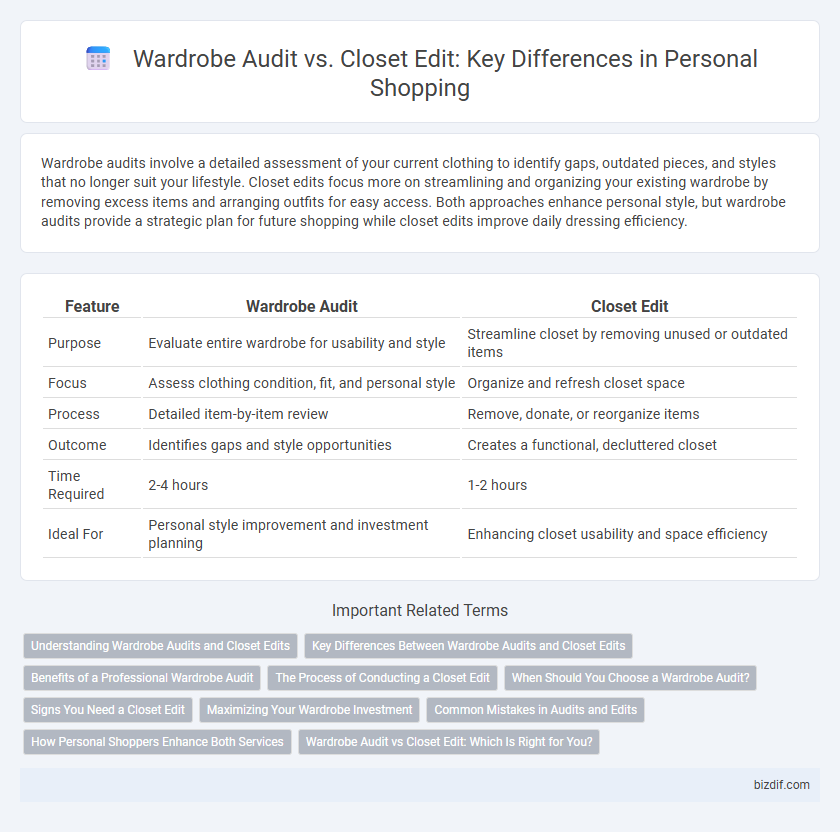Wardrobe audits involve a detailed assessment of your current clothing to identify gaps, outdated pieces, and styles that no longer suit your lifestyle. Closet edits focus more on streamlining and organizing your existing wardrobe by removing excess items and arranging outfits for easy access. Both approaches enhance personal style, but wardrobe audits provide a strategic plan for future shopping while closet edits improve daily dressing efficiency.
Table of Comparison
| Feature | Wardrobe Audit | Closet Edit |
|---|---|---|
| Purpose | Evaluate entire wardrobe for usability and style | Streamline closet by removing unused or outdated items |
| Focus | Assess clothing condition, fit, and personal style | Organize and refresh closet space |
| Process | Detailed item-by-item review | Remove, donate, or reorganize items |
| Outcome | Identifies gaps and style opportunities | Creates a functional, decluttered closet |
| Time Required | 2-4 hours | 1-2 hours |
| Ideal For | Personal style improvement and investment planning | Enhancing closet usability and space efficiency |
Understanding Wardrobe Audits and Closet Edits
Wardrobe audits involve a thorough assessment of your entire clothing collection to identify gaps, outdated items, and pieces that no longer fit your style or lifestyle. Closet edits focus on refining and organizing existing garments, removing clutter, and prioritizing versatile, wearable outfits to enhance daily dressing efficiency. Both strategies optimize personal style, but wardrobe audits provide deeper insights for intentional shopping, while closet edits maximize current wardrobe utility.
Key Differences Between Wardrobe Audits and Closet Edits
Wardrobe audits involve a detailed evaluation of your entire clothing collection to identify gaps, outdated pieces, and styles that no longer suit your lifestyle. Closet edits focus on rearranging and styling the existing items to maximize outfit potential and improve accessibility. The key difference lies in audits being more analytical and strategic, while closet edits are practical and design-oriented.
Benefits of a Professional Wardrobe Audit
A professional wardrobe audit provides a thorough analysis of your clothing, ensuring each item aligns with your style, fit, and lifestyle needs, which maximizes outfit potential and reduces clutter. Expert insights uncover hidden pieces and recommend strategic additions, enhancing versatility and saving money on unnecessary purchases. This tailored approach boosts confidence and streamlines daily dressing by creating a cohesive, functional wardrobe.
The Process of Conducting a Closet Edit
A closet edit involves a detailed assessment of each clothing item to evaluate its fit, condition, and relevance to current style goals. The process includes categorizing pieces by type and season, identifying gaps or redundancies, and making decisions on what to keep, donate, or tailor. This hands-on approach streamlines the wardrobe, enhances outfit coordination, and supports sustainable fashion choices.
When Should You Choose a Wardrobe Audit?
Choose a wardrobe audit when you need a comprehensive evaluation of your clothing to identify gaps, assess fit and style consistency, and align your wardrobe with your current lifestyle and goals. This process is ideal for seasonal transitions, weight changes, or significant style shifts, providing personalized recommendations for purchases and removals. A wardrobe audit delivers in-depth insights that go beyond surface-level organization, ensuring a functional and cohesive collection.
Signs You Need a Closet Edit
A wardrobe audit identifies gaps and excesses in your clothing collection, while a closet edit focuses on decluttering and organizing for daily use efficiency. Signs you need a closet edit include difficulty finding items, clothes you no longer wear taking up space, and an overwhelming amount of choices that hinder outfit decisions. Streamlining your closet enhances outfit coordination and ensures your wardrobe truly reflects your current style and lifestyle.
Maximizing Your Wardrobe Investment
A wardrobe audit involves assessing your entire clothing collection to identify gaps, duplicates, and underused items, helping maximize your wardrobe investment by ensuring each piece serves a purpose. A closet edit focuses on refining your current selection by removing outdated or ill-fitting garments, creating a curated, versatile wardrobe that enhances your style and usability. Both methods optimize wardrobe efficiency, reduce unnecessary purchases, and highlight the importance of quality over quantity for long-term value.
Common Mistakes in Audits and Edits
Common mistakes in wardrobe audits include overlooking seasonal pieces and failing to assess garment condition accurately, which leads to incomplete evaluations. Closet edits often suffer from emotional attachment to items, resulting in clutter retention and poor space optimization. Both processes benefit from objective criteria and regular maintenance to enhance wardrobe efficiency.
How Personal Shoppers Enhance Both Services
Personal shoppers enhance wardrobe audits by meticulously analyzing clients' clothing for fit, style, and current trends, providing tailored recommendations that maximize outfit potential. During closet edits, they efficiently declutter and reorganize by removing outdated or rarely worn items, ensuring the remaining pieces align with the client's lifestyle and fashion goals. Their expert eye and personalized advice transform both services into practical, stylish solutions that elevate clients' overall wardrobe management.
Wardrobe Audit vs Closet Edit: Which Is Right for You?
A wardrobe audit thoroughly evaluates your entire clothing collection to identify gaps, fit issues, and style consistency, helping you make informed decisions on future purchases. A closet edit focuses on curating and organizing what you already own by removing items that no longer serve your style or lifestyle. Choosing between a wardrobe audit and closet edit depends on whether you seek a comprehensive style overhaul or a streamlined wardrobe organization.
Wardrobe audit vs Closet edit Infographic

 bizdif.com
bizdif.com